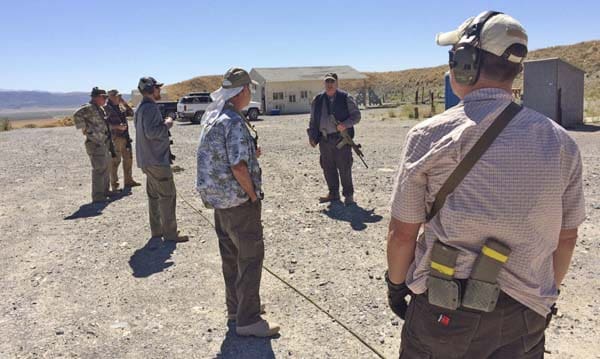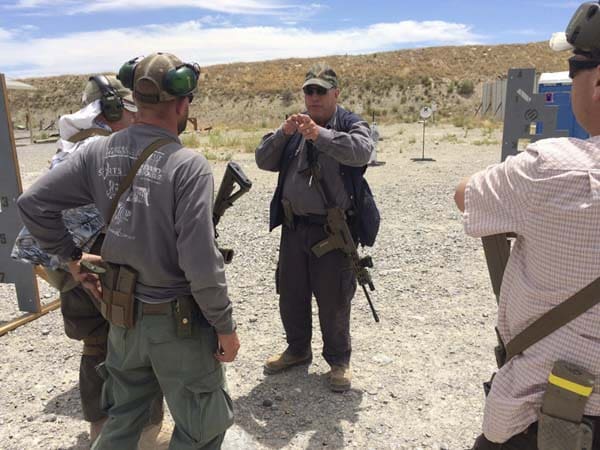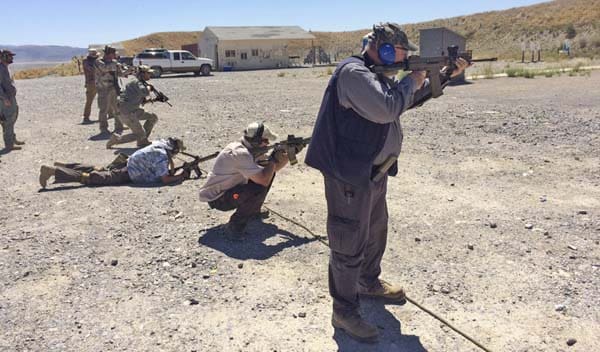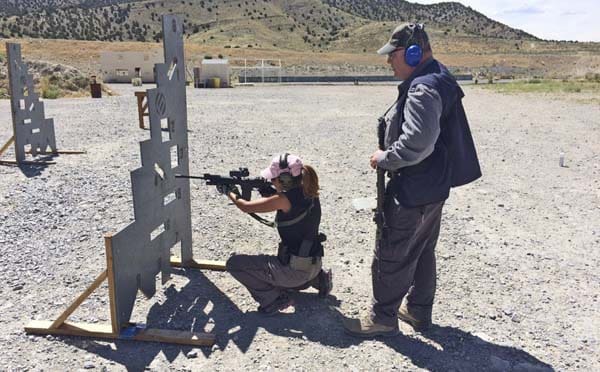
by Steve Barsky
There are many firearms trainers to be found in the U.S. but I have always gravitated towards those with a law enforcement or military background, with real world experience. Among the top trainers in this country, if not the world, is John Farnam.
John has both a military background as well as having served for many years as a deputy in Colorado. He is the author of four textbooks including, The Farnam Method of Defensive Handgunning, The Farnam Method of Defensive Shotgun and Rifle Shooting, The Street Smart Gun Book, and Guns & Warriors – DTI Quips Volume 1.
In June of 1996, John was selected by his peers to receive the renowned “Tactical Advocate of the Year” award from the National Tactical Association. He has also served as an expert witness in numerous firearms related legal cases.
I’d always wanted to train with John, but up until I retired his courses did not mesh with my schedule. This year, he offered his course, “Armed Response to a Terrorist Attack” in Utah. I jumped at the chance to attend a course close to home. (For a complete schedule of Farnam’s courses visit Defense Training International.)

The course was held over two days at “The FARM” near Lehi, Utah. As it’s about a 35 minute run to town from the range, you had two have all your required gear with you.
The class started on Friday morning at 9:30 and ran until 10:00 P.M. that night, followed by another eight-hour day on Saturday.We started with an extensive safety briefing and course introduction. We discussed our expectations and what the course would entail.
John was joined by three very capable assistants, including Jeff Tueller, son of Dennis Tueller of Tueller Drill fame. Jeff also runs the Defense Training International web site for Farnam and they have taught together for several years.
The other main instructor: Matt Newbold. Matt also makes very nice Kydex holsters, which he sells through his operation, MilitisKydex. Since there were only five students in the course, we had an outstanding instructor-to-student ratio.

All of John Farnam’s courses are run as “hot ranges”; it’s refreshing to be treated as an adult at a firearms course. In all but a very few instances, we were responsible for loading and unloading our weapons on our own, and keeping them in a constant state of readiness. Since this was a combined pistol and carbine course, our pistol was loaded and holstered, and our AR-15 was loaded and slung, even during breaks, loading, and lunch.
The course started out with us confirming zero on our rifles. Everyone was expected to have their iron sights co-witnessed with any red dot optic they were running. We also spent some time on trigger reset exercises.
During the course, Farnam emphasized that there is no one answer to any problem, and there is no one way to do things. With this in mind, he would give the minimum instruction for any exercise and allow us to work out a solution — provided it was safe and effective. He wanted us to push ourselves to the point of failure; it’s better to fail on the range and learn our capabilities than to fail in the real world.
On Friday, we engaged in what John termed the “Mother-in-law” drill, or how to save your mother-in-law if she’s being held by an armed hostage. If you decided to solve this “problem” with your AR, it’s important to remember to aim for the top of the head when shooting at close quarters.
The FARM offers a shoot house to accommodate live fire. The shoot house’s footprint probably approaches 1800 square feet.
On Friday afternoon, we participated in a tactical scenario set up by John’s assistants. We returned home to find the front door kicked open. We could hear an angry individual screaming at our family. Your AR was in the house, so you entered the structure with your pistol and decided whether to solve the problem with your pistol or AR.
I chose to retrieve my AR. My first order of business: go to the room where it was located. One of the instructors was up on the catwalk above the ground floor, while another steered you through the house from behind.
The instructor on the catwalk screamed hostilities at my “family,” demanding to know where the drugs and money were located. He fired a gun to add to the stress level. I managed to locate the hostage and take the bad guy out of the fight, without hitting the hostage.
On Friday night we continued to shoot through low light all the way into darkness. We evaluated how our red dot sights worked in low light. We also tested weapon-mounted light we might employ.
On Saturday morning we met with John and his assistants for breakfast. We got to know a man who can quote Shakespeare and, in the next moment, tell you a “salty” story from his military or law enforcement experience. John Farnam is an engaging, witty personality, who sees the world the way it is, and tells it like it is.

On Saturday, we engaged in exercises mixing hostile “bad guys” with unarmed civilians.
Farnam presented his philosophy on how to deal with terrorists, pulling no punches. He pointed out how you cannot expect to be rescued and that your odds of survival go down as the length of time you’re held as a hostage go up.
Saturday’s shoot house scenario was even more challenging than the first. In this case, we were at an art gallery with our family when terrorists attacked intending to take hostages. The situation starts with the student in the bathroom when the first shot rings out.
We were limited to our pistol and we had to solve the problem with classical music playing in the background, accented by gunfire and screaming terrorists. There were numerous “no shoot” civilian targets interspersed with the terrorist targets. Several of the bad guy targets were reactive, so you had to take alternative action if they did not go down.
On Saturday evening after the conclusion of the course, most of the students and all of the instructors got together for dinner in Lehi. Dennis Tueller showed up for dinner, an added bonus.
Over the years I’ve trained with five different firearms trainers, all of whom have either had law enforcement or military backgrounds. I can say without hesitation that I would train again with John Farnam. He’s a consummate professional and someone who can help prepare civilians for the terrible realities of this world.
Steve Barsky is an avid shooter, hunter, archer, and reloader.




“the “Mother-in-law” drill, or how to save your mother-in-law if she’s being held by an armed hostage. If you decided to solve this “problem” with your AR, it’s important to remember to aim for the top of the head when shooting at close quarters.”
I never liked my first mother-in-law, but if she was held hostage I wouldn’t shoot her on the top of her head. I’d aim for center mass.
Funny Ralph, glad to know I wasn’t the only one that it hit that way!
The mother-in-law drill calls for shooting the bad guy! It’s considered poor form to take out the hostage, even if it is your mother-in-law.
Not so, in this case you should immediately shoot the hostage thus removing all of the hostage takers leverage (kidding..but seriously)
What if you only “winged” her just a little.
Didn’t get along all that well too much drama. And her and her daughter, my ex had a double wedding. How cute.
But then again no wifey and my dogs don’t care how many firearms I acquire, as long as they’re fed have water and go out. Besides my dogs don’t have thumbs so they can’t waste my ammo. My 95 lb Catahula loves the sound of gunfire. She’ll wait until I pull the trigger, looking up at me waiting, bang, and she goes off in the direction looking for something dead. Not happy when I target shoot.
“What if you only “winged” her just a little.”
Like in “The Negotiator”?
Read the website the prices are fairly reasonable compared to a lot of the competition but their waffle language on prerequisites makes me wonder.
I’m sick of that shit. I queried multiple places around here in Colorado about a shooting on the move tuneup and they all basically told me I had to spend thousands of dollars on prerequisite classes before they’d allow anything other than standing in one place. Doesn’t matter if you separated from the SEALs yesterday without prerequisite classes FROM THEM you’re a noob to them.
So I said “fuck it” and designed my own spot out in the middle of no where.
I hear you. I don’t train with some local people here in Southern Utah precisely because they wanted my wife and I to attend a handgun boot camp for two days for $750.00 despite the fact we both had completed over 7 handgun training courses.
I don’t believe John Farnam’s requirements are that strict. We had a range of experience in the class, including a 19 year old girl, who I am pretty sure was NOT a Navy SEAL. You had to have some prior training experience, but certainly nothing unreasonable. I personally put a lot of value on training because it’s too easy to form bad habits if there’s never anyone to critique you.
I’ll give them a call and see what’s what then.
I’m just tired of the “You must meet these requirements from OUR classes” bullshit which translates to “If you want to use our shoothouse then pay us thousands”.
Last time I heard that I almost took the pansyassed kid’s throat out with my hands. I’ve been shooting since I was six and the training my father and grandfather gave me was reinforced and augmented by joining the youth program known as “Uncle Sam’s Misguided Children”.
Same frustrating experience here. I found a place in Ft Worth that listens to your experience and let’s you decide which course is for you: Firearms Training Fort Worth. Excellent staff, small but useful range. I’ve taken two classes, and my wife attended one with me. That’s some of the best gun money I’ve ever spent.
Pistol, rifle or both?
If pistol:
Have you shot or considered IDPA? A certain percentage of every match is required to be shot while moving.
The matched I’ve been to were low key and always got pointers from some of the really good shooters.
I don’t think you really need specific-paid-for training to work on shooting while moving. All you may need is practice with other skilled shooters watching what you are doing for a ‘critique.’
At the same time I totally understand the impulse from them. They don’t know if you just separated from X high speed military outfit and have probably seen a bunch of people who claim to have BTDT who muzzle everyone on the line twice.
They don’t know you… and neither do the other people in the class who want to make sure they don’t get shot by someone who might get complacent.
I was a Farnam fan for a lot of years, but I can’t take him seriously anymore, not after his article on how cops aren’t shooting enough people. When he encourages an officer to shoot someone who, in the officers word’s “wasn’t sure he was an imminent threat”, that’s when I had to look much closer to what Farnam was preaching. When he then white washed a careless negligent discharge that resulted in the injury of an officer as “accidents happen”, I had to stop considering him a credible source. Which is a shame, because he was a total hero for a lot of years.
John Farnam’s comments during the course, which were extensive, did not reflect anything like what you mention. I’ve also read his “quips” for years, and don’t recall anything quite like what you’re saying. Perhaps you are quoting him out of context, as certainly his whole articles are not posted here.
Nope. Very much in context. Do a quick search on this site and you will find both of the articles in their entirety.
@jwtaylor – you are taking Farnam’s comments WAY out of context. When he speaks of cops not shooting people that they should, what he is refering to is, the officer(s) not knowning when it is appropriate or, hesitating out of political fear. He has been preaching that for as long as I have trained with him. He has never said anything as you present it. If he has, quote the source please?
Also – what ND incident are you referring to? Farnam talks about these incidents all the time and is very practical in that: These incidents do, and will continue to happen. The only thing we can do is be as safe as we can. However, we also have to realize that other folks and their lack of gun handling skills will always contribute to these incidents happening.
Steve, as jwt said, his articles have been published here several times.
I was going to say something similar. Used to be a fan. Now; not so much. I have been in Law Enforcement, and I found his remarks objectionable.
Certainly not the type of comments one would expect.
The whole “weapons training” industry tends comes off as a huge shuck-and-jive. I can say a similar thing about most CCL certification courses. Both seem to have attracted a plethora of low-self-image poseurs. Poseurs tend to make abysmal teachers. People with genuine professional backgrounds and effective teaching skills are pretty thin on the ground—usually because they have better things to do with their time.
Comments are closed.